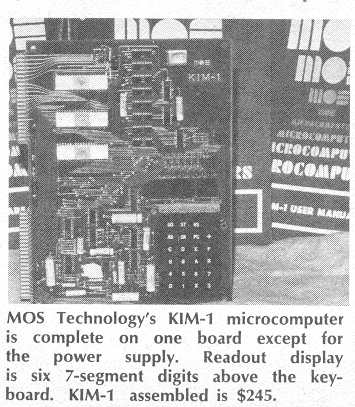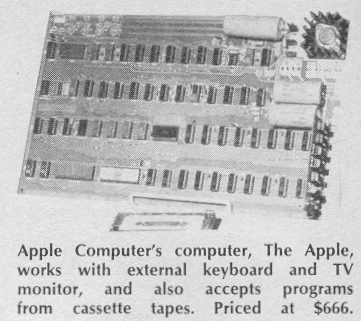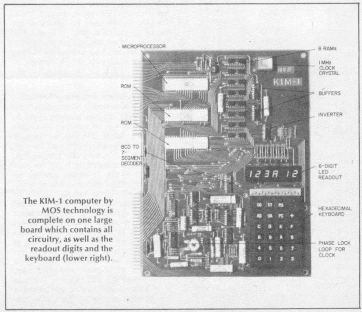 Last time around we introduced a mighty-midget called
Microtutor.
We saw how that RCA pocket-sized computer can control external electronic
devices and we wrote a computer program for it called Secret
Password that opened only when the proper combination of letters and
numbers was punched into the computer. This time we have a firsthand
review of the fabulous microcomputer fair for hobbyists held in Atlantic
City recently. In addition, we'll take a good, hard look at one of the
most popular microcomputers at the fair - the KIM-1 by MOS Technology.
The KIM-1 is unusual not only because it is a fully operational computer
on a 9-inch by 10-inch printed circuit board, but also because the price
is relatively low and it has good expansion capability.
Last time around we introduced a mighty-midget called
Microtutor.
We saw how that RCA pocket-sized computer can control external electronic
devices and we wrote a computer program for it called Secret
Password that opened only when the proper combination of letters and
numbers was punched into the computer. This time we have a firsthand
review of the fabulous microcomputer fair for hobbyists held in Atlantic
City recently. In addition, we'll take a good, hard look at one of the
most popular microcomputers at the fair - the KIM-1 by MOS Technology.
The KIM-1 is unusual not only because it is a fully operational computer
on a 9-inch by 10-inch printed circuit board, but also because the price
is relatively low and it has good expansion capability.
Computer Show. Two big crowd pleasers appeared in Atlantic City recently. One was the Miss America Pageant, the other was the Personal Computing '76 Fair. These two attractions had several points in common. Both showed attractive young females, both showed the latest equipment models and demonstrations of talent, and both attracted lots of attention. The Personal Computing '76 Fair was the first national computer show for hobbyists, and it drew about 5,000 people during the two days it latest. Sponsored by the Southern Counties Amateur Radio Association of New Jersey, the Fair was quite successful, with other 100 exhibitors showing computers and related products. You may ask why an amateur radio group would be interested in microprocessors and the like. The answer helps show how microprocessors and microcomputers are proliferating into more and more areas.
There are several reasons why radio amateurs are interested in microcomputers. One reason is that hams are, like you and me, electronic hobbyists who want to use electronics in powerful ways at little cost. Certainly microprocessors are powerful, and some of them are exceptionally inexpensive - as low as $10 in some cases! Another reason is that there is a real challenge in combining the technology of computers and amateur radio. (Ed. note: as we go to press a journal devoted to small computers has come across my desk, and over half the issue - six articles - is devoted to computer-ham interface.) Another reason for radio amateurs interest is that there's such a challenge in combining the two technologies.
One product getting lots of attention these days, for example, is a Morse code keyboard. You type on the keyboard (just like typewriter keyboard) and Morse code, or an encrypted code goes out on the amateur radio airways - as fast as you can type. At the receiving end another microprocessor decodes the dots and dashes to generate words on a TV screen.
Another example; imagine a small CB walkie-talkie with a small keyboard with numbers 0-9. Pressing a button generates a tone which is relayed to a centrally-located microcomputer. The microcomputer takes the number you pressed on the keyboard and decodes it (via a memory look-up) into a phone number. The microcomputer, through a telephone connection, then connects your walkie-talkie to the telephone of the person you called. If you want to change the keyed code that connects you to your friend's telephone, you only have to change the digits in the memory of the microcomputer.
The possibilities for using radio-controlled devices becomes almost boundless with microprocessors. Model airplanes, boats, trains, and cars, can carry small microprocessor-oriented devices that respond in intelligent ways to radio signals from the operator, as well as to traffic conditions, other vehicles, and so on.
Changes Ahead. The most outstanding message at most booths of the Fair was that, although inexpensive hobby computer equipment that does incredible things is available right now, much more is coming. The hobbyist as well as the commercial or industrial designer will see plenty of improvements, both in hardware and in software. Hardware changes ahead will bring more memory, faster cycle times, and for less money. There'll also be instructions that can be accepted by the microprocessor units, and really good, small input/output devices. The latter will probably be small cathode-ray-tube displays, small keyboards, and clever printers. An example of such a printer, and a sign of things to come is the Southwest Technical Products Corp's PR-40 printer. It's about the size of a small bread toaster yet it just flies across the four-inch-wide paper as it prints letters and numbers with a dot matrix.
Software improvements of the future will not only let you write programs easier, but also use more pre-written, or canned, programs that are simply read into your shoebox-sized computer, via an ordinary cassette player.
Star Trek Video Game. One of the most popular (and fun) programs currently available is a TV space-war game called Star Trek, and it was in use at the Fair. Mr. Spock's spaceship, the Enterprise, is the champion of justice in the game against the Klingons. Rockets, or phasors, can be fired by the space-ships on the TV screen, and the ships can maneuver, refuel, and change their flight characterstics in this sophisticated game. There are so many variables that can be changed in this game that a manual is provided, called the Starfleet Technical Manual.
Just walking from one booth to another at the Fair was like walking through a candy store. Every processor, computer, printer, TV game, keyboard, and module was interesting and tempting. Digital Equipment Corporation (DEC) even had a model railroad layout controlled by their LSI-11 computer. The train could start, stop, wait, and change direction along a multi-switched path, all under computer command.
More New Micros. Motorola announced that they will have a low-cost microcomputer kit available soon, It will have keyboard input, a six-digit LED output, memory, and teletype interface capability. The unit will be based on the Motorola 6800 microprocessor, a quite powerful device. Price will be around $200.
In a similar move, EBKA Industries in Oklahoma showed a brand-new kit, the 6502 Familiarizer, which was humming away. The 6502 contains a printed circuit board 9-inches by 12-inches and a keyboard, two-digit LED display, 1024 bytes (8 bits to a byte) of RAM (random access memory), and 256 bytes permanently stored in a PROM (programmable read-only memory). The program is put in the PROM before the kit is shipped, allowing the Familiarizer to automatically perform some pretty handy functions. The digits on the LED display, for example, move to the left as the keyboard buttons are pressed and then the digitts are automatically shifted into the RAM.
The basic kit sells for $229, and there are other boards that can be added to turn the unit into a more powerful computer. You can add more RAM, or you can add a PROM board which is programmable from the instructions you enter on the basic board. With this PROM your program will always be there, even when you turn the power off then on again - which is not true for RAM. In addition a cassette tape recorder can be connected to the Familiarizer to store programs for later play back.
 The Apple Computer.
The Apple Computer Company showed their Apple computer, priced at $666.66.
This is a bit expensive for beginning hobbyistts, but it offers a lot.
A keyboard and TV monitor connect directly to the Apple. A program,
Apple Basic, is available on a cassette tape that allows the user to
write programs in an easy-to-understand language. Further, Apple Basic
finds bugs (worms) in your program and prints out error messages telling
just what is wrong.
The Apple Computer.
The Apple Computer Company showed their Apple computer, priced at $666.66.
This is a bit expensive for beginning hobbyistts, but it offers a lot.
A keyboard and TV monitor connect directly to the Apple. A program,
Apple Basic, is available on a cassette tape that allows the user to
write programs in an easy-to-understand language. Further, Apple Basic
finds bugs (worms) in your program and prints out error messages telling
just what is wrong.
More Hardware. Another company, Wave Mate, was showing their Jupiter II computer, designed to control industrial equipment like wire-wrapping machines and milling machines. And MITS, makers of the Altair computer discussed in July/August, 1976 in this column, was there with a large display of equipment and computer programs. Finally, National Semiconductor, the company that sends you a computer kit in a ring binder notebook, was showing their SC/MP (pronounced "Scamp") computer. One SC/MP was operating a TV screen while another responded to one's teletype inputs.
There was a great deal to see - much too much to describe further, but this should give you an idea of what you missed if you weren't at the Computer Fair this year. There'll be another hobby Computer Fair next year, and we'll keep you posted on this interesting event well ahead of time.
 KIM-1, a Bargain Microcomputer.
MOS Technology in Norristown, Pennsylvania, has named its popular
microcomputer the KIM-1. It comes already assembled on a 9-inch by
10-inch printed circuit board, and has everything you need to make
it work except a 5-volt power supply. The board carries the microprocessor
chip, memory, input/output control chips, a keyboard for writing programs
and entering data, and a six-digit LED display. The display can show the
address and contents of any memory location you select. The unit comes
with three manuals:
KIM-1, a Bargain Microcomputer.
MOS Technology in Norristown, Pennsylvania, has named its popular
microcomputer the KIM-1. It comes already assembled on a 9-inch by
10-inch printed circuit board, and has everything you need to make
it work except a 5-volt power supply. The board carries the microprocessor
chip, memory, input/output control chips, a keyboard for writing programs
and entering data, and a six-digit LED display. The display can show the
address and contents of any memory location you select. The unit comes
with three manuals:
1. The User's Manual, which gives an overview of the design of the
microcomputer and how to use it.
2. The Hardware Manual, which explains each of the chips and various
hardware interfaces that can be used.
3. The Programming Manual, which provides a detailed description of each
of the 56 basic instructions and the possible variations of those
instructions.
In addition, expansion memories and software that eases programming tasks have recently been announced. Total cost of the KIM-1 is $245, a real bargain.
How It Works. Let's take a closer look at the make-up of this bargain microbrain. The four left-most digits of the display show the address of a selected memory location in hexadecimal code (explained in our November/December, 1976 issue. For example, 0000 is the first location and 03FF is the one-thousandth location [sic]. The two right-most digits always show the data that is in, or being put into, a memory cell. The data (or any address) can be selected by the keyboard, which has the hexadecimal values 0 through F (0 through 15 in decimal notation) along with control keys.
| Decimal | Hexadecimal | |
|---|---|---|
| 0-9 | 0-9 | |
| 10 | 0A | |
| 11 | 0B | |
| 12 | 0C | |
| 13 | 0D | |
| 14 | 0E | |
| 15 | 0F | |
| 16 | 10 | |
| 17 | 11 | |
| 31 | 1F | |
| 32 | 20 |
The control keys are GO for making your program run, ST to make it stop, RS for reinitializing your program (or peripheral devices), AD for selecting the address mode - that is, any keys you press will show on the left-most LED digits - DA for selecting the data mode (enter data via the keyboard), PC to display the contents of the program counter which keeps track of the next memory location to be used in the program, and + which increments the displayed address by one. There is also a slide switch marked SST which can be used with the GO key to step through a program one step at a time - a handy and unusual feature.
Lots of IC Chips. There are lots of integrated circuit chips on this KIM-1 board. The nerve center is the MCS 6502 microprocessor chip. This chip has a 16-bit address bus for addressing 65,536 memory and input/output locations. It also has an 8-bit bidirectional data bus (the data bus transfers data to the location specified by the address bus), and two input ports that accept interrupt signals. These order the program to stop temporarily, or to change course.
The memory center of the KIM-1 is in eight MCS 6102 RAM (random access memory) chips that provide a total of 1024 locations, each holding 8 bits, for the user to store his program and data.
AD
0 0 0 0 0000 XX
DA
0 4 0000 04
+ 0 5 0001 05
+ GO 0009 XX
Finally, the input/output control of the unit is contained in two MCS 6530 chips each of which contain 1024 locations of ROM (read only memory) that have been stuffed with monitor and executive programs. These programs are safe from accidental destruction (when power is off) because they are stored in the ROMs. They control the display of digits on the LED readout; they receive and translate digits from the keyboard; and they permit teletype (TTY) connection, as well as regulating all input and output of the KIM-1.
A Simple Program. Let's write a program that simply adds any two numbers and displays the results. First memory location 0002 is selected via the keyboard, then the Data Address mode is selected, to start putting instructions (data is a misnomer here) into memory. The instructions load a special memory, called an accumulator, with the number in memory location 0000, then add it to the number from location 0001. The result is automatically placed in the accumulator but the program, at steps 0006 and 0007, places the sum in location 00FA and the remaining steps use ROM-stored programs to display the result.
Our program is flexible because it will add together any numbers you place in locations 0000 and 0001. To put numbers there, just address the locations, press DA for data mode, enter your desired values, then press GO to run the entire program. In my example the values 04 and 05 will be added and 09 will be displayed. Note that the display program in the ROM is tricky - it causes the result to appear at what is normally the address side of the display because there are four digits available there. You are probably saying to yourself about now that using a microcomputer can't be this easy - but it is.
Next Time. In our next column we'll have a lot more of KIM-1 to read and learn about. We'll see how it connects to an inexpensive cassette tape recorder to allow programs to be saved. I'll also tell about a Users Group that has sprung up and has written some clever programs. And I'll describe MOS Technology's interesting new hardware that can be connected to KIM-1 to increase its memory and let it take via a TV screen. If you have some special subjects you would like to see covered in this column, just drop me a line.
| Press Keys | Display | Action |
|---|---|---|
| AD | ||
| 0 0 0 2 | 0002 XX | Select location 0002 |
| DA | 0002 A5 | Load accumulator |
| A 5 | 0003 00 | from location 0000 |
| + 0 0 | 0004 65 | Add value in location |
| + 6 5 | 0005 01 | 0001 to accumulator |
| + 0 1 | 0006 85 | Store accumulator value |
| + 8 5 | 0007 FA | in location 00FA |
| + F A | 0008 4C | |
| + 4 C | 0009 4F | Display result |
| + 4 F | 000A 1C | |
| + 1 C |